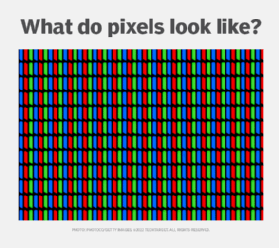hue, saturation and brightness
What are hue, saturation and brightness?
Hue, saturation and brightness, or HSB, are aspects of color in the red, green, and blue (RGB) scheme. These terms are most often used in reference to the color of each pixel in a cathode ray tube (CRT) or newer display. All possible colors can be specified according to hue, saturation and brightness just as colors can be represented in terms of the R, G, and B components.
The terms originated in an era of now-outdated CRT-based computer displays and color televisions. However, hue, saturation and brightness can be observed in modern liquid-crystal display, light-emitting diode and in graphics displays. In these newer displays, graphics software controls these properties in the images.

What is hue?
Most sources of visible light contain energy over a band of wavelengths. Hue is the wavelength within the visible-light spectrum at which the energy output from a source is greatest. This is shown as the peak of the curves of intensity in Figure 2. In this example, all three colors have the same hue in the yellow-green portion of the spectrum.

How is hue related to brightness?
Hue represents the color being displayed, as found on a red-green-blue scale, color wheel or grayscale. The intensity of the primary colors or gray displayed grows with increased brightness, but the color itself does not change.
Changing to different color values makes no difference. It is like changing the brightness of a light bulb that sits behind a transparent piece of plastic with a specific color. As the voltage in the light bulb increases, the light intensity increases, but the color or hue remains unchanged.

What is saturation?
Saturation is an expression for the relative bandwidth of the visible output from a light source. In Figure 2, the saturation is represented by the steepness of the slopes of the curves. The red curve represents a color with low saturation. The green curve represents a color with greater saturation. And the blue curve represents a color with fairly high saturation.
As saturation increases, colors appear sharper or purer. As saturation decreases, colors appear more washed-out or faded. When no gray appears in the color, 100% saturation has been achieved.
The term saturation is used in other fields, such as fluids and semiconductor saturation.
What is brightness?
Brightness, which is also referred to as brilliance, is an expression of the relative intensity of the energy output of a visible light source. It can be expressed as a total energy value, which is different for each of the curves in the Figure 2. Another way to express brightness is the amplitude of the wavelength where the intensity is greatest.
In the RGB color model, the amplitudes of red, green and blue for a particular color can each range from 0% to 100% of full brilliance. These levels are represented by decimal numbers from 0 to 255 or hexadecimal numbers from 00 to FF.
Brightness is not limited to simply increasing or decreasing the amount of light added to the color. It is possible to increase the apparent brightness of an image by placing it next to a darker image. For example, a warm color, such as orange, can appear cooler when placed next to a much warmer color, such as red or yellow.
Why are hue, saturation and brightness important?
When working with color photography or printing systems, knowledge of these three characteristics helps ensure the best results. Using a photo or print application provides flexibility in mixing colors, adjusting contrast, inserting grayscale elements, and adjusting saturation and brightness. And these tasks can all be done in Real Time.
For example, the Adobe Photoshop application has tools that can modify hue, saturation and brightness to improve color qualities in images. Users can select specific colors, such as magenta or cyan, and manipulate them at the pixel level. Color gradients, or variations, can be used to obtain an optimum hue.

Achieving an optimum color presentation
Knowledge of color theory is useful to achieve what is referred to as color harmony -- that is, colors that are placed in ways that are pleasing to the human eye. Color theory explores how the human eye perceives color and how colors found on a color wheel or color palette can be positioned for maximum comfort to the eye and person.
On a color wheel, colors directly opposite one another are complementary. Use of such colors satisfies the eye's desire for balance and harmony. Adding the factors of hue, saturation and brightness provides further variations of color design.
Color mixing provides additional hues for consideration. For example, combining red, green and blue -- the primary colors of light -- results in secondary colors magenta, cyan and yellow. Mixing red, green and blue light equally results in white light. Similar results occur when subtracting or removing colors.
Presentation and color choices are important in advertising and marketing, and they're becoming more important as that industry evolves. Learn more about marketing in the metaverse and what that could mean for all sorts of technology use.
